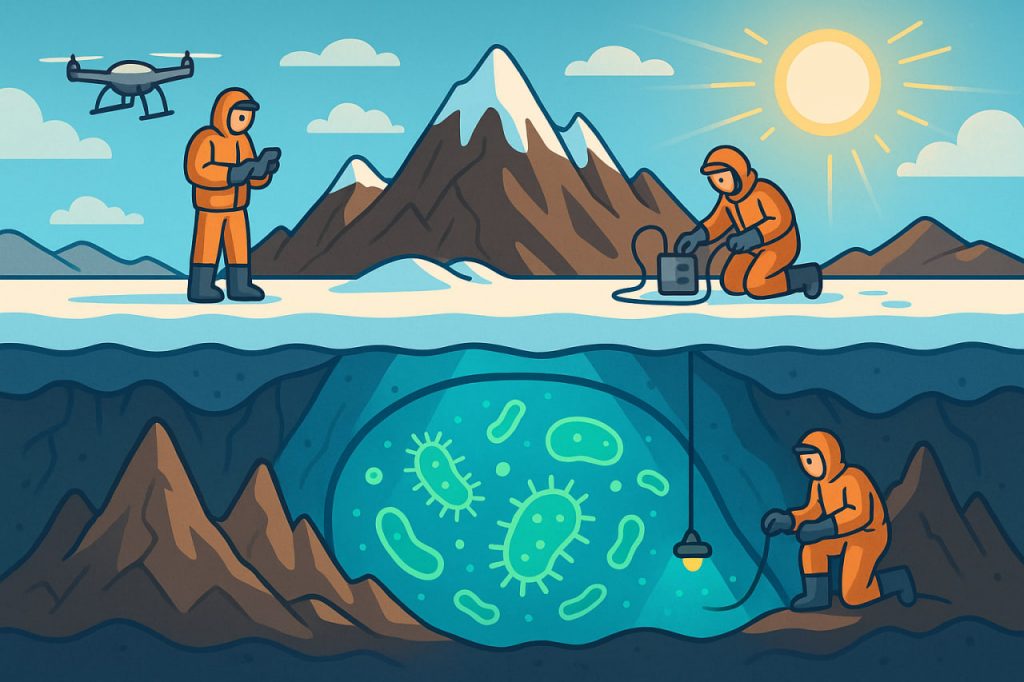Antarctica, the coldest and most mysterious continent on Earth, is a frozen world that hides countless secrets beneath its thick ice sheets. While it appears lifeless and barren, this icy desert conceals vast mountain ranges, ancient lakes, and possibly traces of ecosystems that have existed for millions of years. Modern technology is only beginning to uncover what lies beneath, revealing a hidden world of geological wonders and scientific mysteries that could reshape our understanding of Earth’s history.
The Ice Shield: Earth’s Frozen Memory
Antarctica’s ice sheet is the largest reservoir of fresh water on the planet, containing about 70% of Earth’s freshwater. In some places, the ice is over 4 kilometers (2.5 miles) thick, and scientists believe it holds a record of our planet’s climate spanning more than 800,000 years.
By drilling deep into these layers, researchers analyze trapped air bubbles to reconstruct ancient atmospheric compositions. This data provides vital clues about climate change, volcanic activity, and global temperature shifts over millennia.
Hidden Mountain Ranges and Valleys
In the 1950s, scientists using radar technology made a stunning discovery: beneath the ice lies an entire mountain range called the Gamburtsev Mountains, roughly the size of the Alps. These mountains are completely buried under more than a kilometer of ice and may hold clues about how Antarctica first froze over.
Alongside them lie vast subglacial valleys — some deeper than the Grand Canyon — such as the Denman Glacier trench, plunging more than 3,500 meters below sea level, making it the lowest land point not covered by ocean.
The Secret Subglacial Lakes
One of the most astonishing discoveries beneath Antarctica is the existence of over 400 subglacial lakes, trapped under ice but remaining liquid due to geothermal heat and immense pressure.
The largest of these is Lake Vostok, hidden under nearly 4 kilometers of ice. It’s about 250 kilometers long and may have been isolated from the surface for more than 15 million years.
Scientists suspect that these lakes could harbor unique microorganisms adapted to extreme conditions, potentially offering insights into life on other planets, such as Jupiter’s moon Europa or Saturn’s Enceladus.
Evidence of Ancient Life and Lost Ecosystems
Sediments taken from the seafloor and under the ice suggest that Antarctica was once a lush green continent, covered in forests and inhabited by dinosaurs during the Cretaceous period.
Fossilized plant spores, ancient pollen, and even remains of tropical flora have been discovered beneath the ice layers, confirming that this now-frozen land was once part of Gondwana, the prehistoric supercontinent that also included Africa and South America.
Some scientists even speculate that microbial life could still survive in isolated ecosystems beneath the glaciers, protected from radiation and extreme cold for millions of years.
The Mystery of Anomalies and Subglacial Structures
Satellite and radar scans have also revealed several mysterious heat anomalies and geometric structures beneath the ice. Some theories suggest they could be natural geothermal features — volcanic systems or impact craters — while others fuel speculation about ancient civilizations or alien relics.
The most discussed is the Wilkes Land anomaly, a massive circular formation more than 250 kilometers wide, which may be the remains of an ancient asteroid impact — possibly the one that triggered the extinction of the dinosaurs.
Modern Expeditions and the Future of Research
International teams using ice-penetrating radar, seismic imaging, and autonomous robots continue to explore Antarctica’s hidden depths. Projects like IceCube detect subatomic particles (neutrinos) traveling through the ice, turning the continent into a gigantic scientific observatory.
In the coming decades, with the help of AI-driven probes and cryobots, scientists hope to explore subglacial lakes directly — potentially finding new life forms or evidence of past planetary climates.
Why It Matters for Humanity
The secrets beneath Antarctica are not just scientific curiosities — they are vital to our survival. The continent plays a key role in regulating Earth’s climate and sea levels. If its ice melts due to global warming, sea levels could rise by more than 60 meters, reshaping coastlines and displacing billions of people.
Understanding Antarctica’s structure and its history helps scientists predict future changes and protect our planet from environmental catastrophe.
Interesting Facts
- Antarctica contains 90% of the world’s ice but receives less annual precipitation than the Sahara Desert.
- The continent has more than 400 known subglacial lakes — most of them still unexplored.
- Radar mapping has revealed hidden rivers flowing under the ice for hundreds of kilometers.
- Mount Erebus, one of the few active volcanoes in Antarctica, constantly emits gas and molten lava despite subzero temperatures.
- Microbial life found in Lake Whillans proved that ecosystems can exist completely cut off from sunlight for thousands of years.
Glossary
- Subglacial — located or occurring beneath a glacier or ice sheet.
- Cryobot — a robotic probe designed to melt through thick ice layers to explore subsurface environments.
- Gondwana — an ancient supercontinent that existed more than 180 million years ago.
- Geothermal heat — natural heat from Earth’s interior that can melt ice deep underground.
- Neutrinos — nearly massless particles that pass through matter, studied to understand cosmic phenomena.


